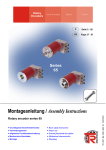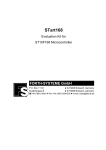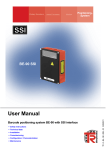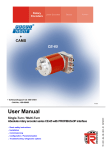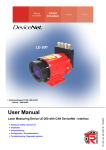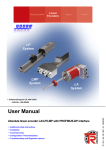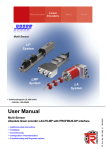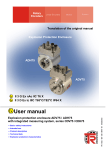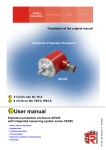Download TR - ELA - TI - GB
Transcript
Rotary Encoders Linear Encoders Motion System Multi-Sensor LP-38 • Software/Support CD: 490-01001 - Soft-No.: 490-00407 5141 Multi-Sensor Absolute linear encoder LP-38 with CAN DeviceNet™ interface • Additional safety instructions • Installation • Commissioning • Configuration / Parameterization • Cause of faults and remedies TR - ELA - TI - GB - 0040 - 03 08/20/2007 User Manual TR-Electronic GmbH D-78647 Trossingen Eglishalde 6 Tel.: (0049) 07425/228-0 Fax: (0049) 07425/228-33 E-mail: [email protected] http://www.tr-electronic.de Copyright protection This Manual, including the illustrations contained therein, is subject to copyright protection. Use of this Manual by third parties in contravention of copyright regulations is forbidden. Reproduction, translation as well as electronic and photographic archiving and modification require the written content of the manufacturer. Offenders will be liable for damages. Subject to amendments Any technical changes that serve the purpose of technical progress, reserved. Document information Release date/Rev. date: Document rev. no.: File name: Author: 08/20/2007 TR - ELA - TI - GB - 0040 - 03 TR-ELA-TI-GB-0040-03.DOC MÜJ Font styles Italic or bold font styles are used for the title of a document or are used for highlighting. Courier font displays text, which is visible on the display or screen and software menu selections. ″< > ″ indicates keys on your computer keyboard (such as <RETURN>). Trademarks DeviceNet is a registered trademark of ODVA (Open DeviceNet Vendor Association) © TR-Electronic GmbH 2007, All Rights Reserved Page 2 of 24 Printed in the Federal Republic of Germany TR - ELA - TI - GB - 0040 - 03 08/20/2007 Contents Contents Contents ............................................................................................................................................3 Revision index ..................................................................................................................................5 1 General information ......................................................................................................................6 1.1 Applicability......................................................................................................................6 1.2 Abbreviations used / Terminology ...................................................................................7 2 Additional safety instructions......................................................................................................8 2.1 Definition of symbols and instructions .............................................................................8 2.2 Additional instructions for proper use ..............................................................................8 2.3 Organizational measures.................................................................................................9 3 Technical data................................................................................................................................10 3.1 Electrical characteristics ..................................................................................................10 4 Multi-Sensor - Technique .............................................................................................................11 5 CAN DeviceNet information ........................................................................................................12 6 Installation / Preparation for start-up ..........................................................................................14 6.1 Connection.......................................................................................................................15 6.2 Bus termination................................................................................................................15 6.3 Identifier (MAC-ID)...........................................................................................................15 6.4 Baud rate .........................................................................................................................15 6.5 Shield cover .....................................................................................................................16 7 Commissioning..............................................................................................................................18 7.1 CAN DeviceNet interface.................................................................................................18 7.1.1 Bus status ........................................................................................................18 7.1.2 EDS file ............................................................................................................19 7.1.3 Messages ........................................................................................................19 7.1.4 Classes ............................................................................................................20 7.1.5 I/O Instance (polled IO)....................................................................................20 8 Parameterization and configuration ............................................................................................21 8.1 Configuration Assembly Data Attribute Format ...............................................................21 8.1.1 Assembly Object 04h.......................................................................................21 8.2 Parameter Object Instances ............................................................................................21 8.2.1 Parameter Object 0Fh .....................................................................................21 8.3 Parameters / Range of values .........................................................................................22 8.3.1 Direction...........................................................................................................22 8.3.2 Output Code ....................................................................................................22 8.3.3 Total Number of Steps.....................................................................................22 8.3.4 Adjust Absolute Value......................................................................................23 © TR-Electronic GmbH 2007, All Rights Reserved Printed in the Federal Republic of Germany 08/20/2007 TR - ELA - TI - GB - 0040 - 03 Page 3 of 24 Contents 8.3.5 Number of Magnets .........................................................................................23 9 Causes of faults and remedies ....................................................................................................24 Appendix LP-38 ........................................................................................................ TR-ELA-TI-GB-0009 © TR-Electronic GmbH 2007, All Rights Reserved Page 4 of 24 Printed in the Federal Republic of Germany TR - ELA - TI - GB - 0040 - 03 08/20/2007 Revision index Revision index Revision Date Index First release 09/26/03 00 Revision of chapter "I/O Instance (polled IO) ", page 20 12/10/03 01 LA-65-H not available as multi-sensor 09/22/06 02 General technical modifications, layout modifications 08/20/07 03 © TR-Electronic GmbH 2007, All Rights Reserved Printed in the Federal Republic of Germany 08/20/2007 TR - ELA - TI - GB - 0040 - 03 Page 5 of 24 General information 1 General information This interface-specific User Manual includes the following topics: • Safety instructions in additional to the basic safety instructions defined in the Assembly Instructions • Electrical characteristics • Installation • Commissioning • Configuration / parameterization • Causes of faults and remedies As the documentation is arranged in a modular structure, this User Manual is supplementary to other documentation, such as product datasheets, dimensional drawings, leaflets and the assembly instructions etc. The User Manual may be included in the customer's specific delivery package or it may be requested separately. 1.1 Applicability This User Manual applies exclusively to the following measuring system models with CAN DeviceNet™ interface: • LP-38 The products are labelled with affixed nameplates and are components of a system. The following documentation therefore also applies: • • • the operator's operating instructions specific to the system, this User Manual, and the assembly instructions TR-ELA-BA-DGB-0004, which is enclosed when the device is delivered © TR-Electronic GmbH 2007, All Rights Reserved Page 6 of 24 Printed in the Federal Republic of Germany TR - ELA - TI - GB - 0040 - 03 08/20/2007 General information 1.2 Abbreviations used / Terminology CAN Controller Area Network (manufacturer independent, open field bus standard) CiA CAN in Automation (CAN User Organization, "Holding organization") DeviceNet™ CAN protocol, defined in the Application Layer (layer 7) DUPMAC-ID-Test DUPLICATE-MAC-ID-Test Checking the master for duplicates of slave MAC-IDs. Each address of the connected slaves may occur only once. EMC Electro Magnetic Compatibility EDS Electronic-Data-Sheet LP Linear-Absolute Measuring System, type with Profile-housing MAC-ID Media Access Control Identifier (node address) ODVA Open DeviceNet Vendor Association (CAN User Organization, especially for DeviceNet™) © TR-Electronic GmbH 2007, All Rights Reserved Printed in the Federal Republic of Germany 08/20/2007 TR - ELA - TI - GB - 0040 - 03 Page 7 of 24 Additional safety instructions 2 Additional safety instructions 2.1 Definition of symbols and instructions means that death, serious injury or major damage to property could occur if the stated precautions are not met. WARNING! means that minor injuries or damage to property can occur if the stated precautions are not met. CAUTION ! indicates important information’s or features and application tips for the product used. 2.2 Additional instructions for proper use The measurement system is designed for operation with CAN DeviceNet™ networks according to the International Standard ISO/DIS 11898 and 11519-1 up to max. 500 kbit/s. The technical guidelines for the structure of the CAN DeviceNet™ network from the CAN User Organization ODVA are always to be observed in order to ensure safe operation. Proper use also includes: • observing all instructions in this User Manual, • observing the assembly instructions. The "Basic safety instructions" in particular must be read and understood prior to commencing work. © TR-Electronic GmbH 2007, All Rights Reserved Page 8 of 24 Printed in the Federal Republic of Germany TR - ELA - TI - GB - 0040 - 03 08/20/2007 Additional safety instructions 2.3 Organizational measures • This User Manual must always kept accessible at the site of operation of the measurement system. • Prior to commencing work, personnel working with the measurement system must have read and understood - the assembly instructions, in particular the chapter "Basic safety instructions", - and this User Manual, in particular the chapter "Additional safety instructions". This particularly applies for personnel who are only deployed occasionally, e.g. at the parameterization of the measurement system. © TR-Electronic GmbH 2007, All Rights Reserved Printed in the Federal Republic of Germany 08/20/2007 TR - ELA - TI - GB - 0040 - 03 Page 9 of 24 Technical data 3 Technical data 3.1 Electrical characteristics Supply voltage................................................ 19-27 V DC, twisted in pairs and shielded Current consumption without load .............. < 250 mA Measuring principle ....................................... magnetostrictive * Resolution .................................................... 0.01 mm Number of magnets ....................................... ≤ 16 Distance between 2 magnets ................ ≥ 50 mm Baud rate (adjustable) ................................... 125 kBaud, line length up to 500 m 250 kBaud, line length up to 250 m 500 kBaud, line length up to 100 m Station addresses .......................................... 0 – 63, adjustable via DIP switches Transmission.................................................. twisted in pairs and shielded copper cable CAN DeviceNet interface ............................... CAN field bus interface (opto-isolated) Data transmission...................................... CAN bus driver (ISO/DIS 11898) Data protocol .................................................. CAN 2.0 A Terminating resistor ...................................... 121 ohm external Special features.............................................. Programming of the following parameters via the CAN-BUS: - Code sequence - Output code (binary, gray) - Measuring length in steps - Direct adjustment via bus EMC ................................................................. DIN EN 61000-6-2 / DIN EN 61000-4-2 / DIN EN 61000-4-4 * parameterizable via CAN DeviceNet © TR-Electronic GmbH 2007, All Rights Reserved Page 10 of 24 Printed in the Federal Republic of Germany TR - ELA - TI - GB - 0040 - 03 08/20/2007 Multi-Sensor - Technique 4 Multi-Sensor - Technique With the multi-sensor type the positions of max. 16 magnets can be detected. The minimum distance between two magnets must be 50 mm. With the I/O Poll Command the magnet (0 – 15) at which the position have to be read is addressed in the output byte. The Respond Message contains the position of the addressed magnet. Principle © TR-Electronic GmbH 2007, All Rights Reserved Printed in the Federal Republic of Germany 08/20/2007 TR - ELA - TI - GB - 0040 - 03 Page 11 of 24 CAN DeviceNet information 5 CAN DeviceNet information DeviceNet™ was developed by Rockwell Automation and the ODVA as an open field bus standard, based on the CAN protocol and is standardized in the European standard EN 50325. Specification and maintenance of the DeviceNet standard is regulated by the ODVA. DeviceNet™, along with ControlNet and EtherNet/IP, belongs to the family of CIP-based networks. The CIP (Common Industrial Protocol) forms a common application layer for these 3 industrial networks. DeviceNet™, ControlNet and Ethernet/IP are therefore well matched to one another and present the user with a graduated communication system for the physical layer (Ethernet/IP), cell layer (ControlNet) and field layer (DeviceNet™). DeviceNet™ is an object-oriented bus system and works according to the producer/consumer model. DeviceNet™ Protocol The DeviceNet™ protocol is an object-oriented protocol. It is typically used for networking sensors and actuators with the superordinate automation devices (PLC, IPC). DeviceNet™ Data Link Layer Layer 2 (Data Link Layer) is based on the Controller Area Network (CAN), which was originally designed for use in motor vehicles. DeviceNet™ Network and Data Transport Layer The link is set up with the Group 2 Unconnected Port. Selected CAN identifiers are used for the link set-up. A link, once set up, can be used for transmitting explicit messages or for setting up additional I/O links. As soon as an I/O link has been set up, I/O data can be exchanged between the DeviceNet™ users. The 11 bit identifier is used exclusively for coding I/O data. The 8-byte wide CAN data field is fully available for user data. DeviceNet™ Application Layer – CIP Protocol The CIP (Common Industrial Protocol) forms the application layer for DeviceNet™. The CIP defines the exchange of I/O data in realtime via I/O messages (I/O messaging or implicit messaging), as well as the exchange of data required for configuration, diagnosis and management via explicit messages (explicit messaging). The communication between two devices always takes place according to a connection-oriented communication model, either via a point-to-point or a multicast-V1 connection. This allows both master/slave and multi-master systems to be realized. Data are known as objects and are logged in the object directory of each device. © TR-Electronic GmbH 2007, All Rights Reserved Page 12 of 24 Printed in the Federal Republic of Germany TR - ELA - TI - GB - 0040 - 03 08/20/2007 CAN DeviceNet information Predefined Master-Slave Connection Set The so-called "Predefined Master/Slave Connection Set" is used for the DeviceNet™ measuring system. This subset of the DeviceNet™ protocol simplifies the transmission of I/O data between an automation system (PLC) and the decentralized peripheral devices (slaves): Only "Group2 Messages" are supported, with the exception of "Group1 Message for Slave I/O Poll Response". DeviceNet™ Device Profiles Beyond the specification of the pure communication functions, DeviceNet™ also includes the definition of device profiles. These profiles define the respective device types for minimally available objects and communication functions. The device type number 08hex was defined for the DeviceNet™ measuring system. Vendor ID The vendor IDs (manufacturer’s identifiers) are assigned and administrated by the ODVA. The TR-Electronic vendor ID for DeviceNet™ is "134" (dec). You can obtain further information on DeviceNet™ from the Open DeviceNet Vendor Association (ODVA) or the following Internet addresses: http://www.odva.org e-mail: mailto:[email protected] © TR-Electronic GmbH 2007, All Rights Reserved Printed in the Federal Republic of Germany 08/20/2007 TR - ELA - TI - GB - 0040 - 03 Page 13 of 24 Installation / Preparation for start-up 6 Installation / Preparation for start-up Up to 64 bus users can communicate with each other in a DeviceNet™ network with Baud rates of 125, 250 or 500 kbit/s. The DeviceNet™ cable provides both signals for CAN-L and CAN-H data transmission, as well as two lines for the 24 Volt operating voltage supply of the DeviceNet™ bus users. The maximum length of the DeviceNet™ cable is dependent on the type of cable selected and the Baud rate. Installation takes place in a bus topology – with or without taps – and terminators at both ends. The terminators have a resistance value of 120 Ohm. Bus lines The bus lines for the DeviceNet™ system are laid down in the DeviceNet™ specification. According to this specification, the maximum extent of a DeviceNet™ system is dependent on the Baud rate: Cable length 125 kbit/s 250 kbit/s 500 kbit/s Total length with thick cable 500 m 250 m 100 m Total length with thin cable 100 m 100 m 100 m 6m 6m 6m 156 m 78 m 39 m Max. drop line length Max. length of all drop lines The DeviceNet™-specification and other applicable standards and guidelines are to be observed to insure safe and stable operation. In particular, the applicable EMC directive and the shielding and grounding guidelines must be observed! © TR-Electronic GmbH 2007, All Rights Reserved Page 14 of 24 Printed in the Federal Republic of Germany TR - ELA - TI - GB - 0040 - 03 08/20/2007 Installation / Preparation for start-up 6.1 Connection The pin assignments with view onto the switches are attached in the rear of this document. For the supply shielded cables with twisted core pairs with min. 0.5 mm2 have to be used ! 6.2 Bus termination If the measuring system is the last slave in the CAN segment, the bus is to be terminated with an external bus terminal resistance of 120 ohms. 6.3 Identifier (MAC-ID) The identifier (measuring system address) 0 – 63 is adjusted via rotary switches. The adjusted address may be assigned only once in the CAN bus. 6.4 Baud rate The baud rate is adjusted via rotary switches. Following baud rates are possible: ● ● ● 125 kbit/s 250 kbit/s 500 kbit/s © TR-Electronic GmbH 2007, All Rights Reserved Printed in the Federal Republic of Germany 08/20/2007 TR - ELA - TI - GB - 0040 - 03 Page 15 of 24 Installation / Preparation for start-up 6.5 Shield cover The shield cover is connected with a special EMC cable gland, whereby the cable shielding is fitted on the inside. Cable gland assembly, variant A Pos. 1 Pos. 2 Pos. 3 Pos. 5 1. 2. 3. 4. 5. 6. 7. Nut Seal Contact bush Screw socket Cut shield braid / shield foil back to dimension "X". Slide the nut (1) and seal / contact bush (2) + (3) over the cable. Bend the shield braining / shield foil to 90° (4). Slide seal / contact bush (2) + (3) up to the shield braining / shield foil. Assemble screw socket (5) on the housing. Push seal / contact bush (2) + (3) flush into the screw socket (5). Screw the nut (1) to the screw socket (5). © TR-Electronic GmbH 2007, All Rights Reserved Page 16 of 24 Printed in the Federal Republic of Germany TR - ELA - TI - GB - 0040 - 03 08/20/2007 Installation / Preparation for start-up Cable gland assembly, variant B Pos. 1 Pos. 2 Pos. 3 Pos. 4 Nut Clamping ring Inner O-ring Screw socket 1. Cut shield braid / shield foil back to dimension "X" + 2mm. 2. Slide the nut (1) and clamping ring (2) over the cable. 3. Bend the shield braining / shield foil to approx. 90°. 4. Push clamping ring (2) up to the shield braid / shield foil and wrap the braiding back around the clamping ring (2), such that the braiding goes around the inner O-ring (3), and is not above the cylindrical part or the torque supports. 5. Assemble screw socket (4) on the housing. 6. Insert the clamping ring (2) in the screw socket (4) such that the torque supports fit in the slots in the screw socket (4). 7. Screw the nut (1) to the screw socket (4). 1 2 3 4 © TR-Electronic GmbH 2007, All Rights Reserved Printed in the Federal Republic of Germany 08/20/2007 TR - ELA - TI - GB - 0040 - 03 Page 17 of 24 Commissioning 7 Commissioning 7.1 CAN DeviceNet interface The CAN field bus interface (separated via optoelectronics with CAN-BUS-Driver PCA82C250T) in the measuring system is determined according to the international standard ISO/DIS 11898 and covers the two lower layers of the ISO/OSI reference module. The transformation of measuring system information into the CAN protocol occurs by the protocol chip SJA1000. The function of the protocol chip is monitored by a watchdog. The PREDEFINED MASTER/SLAVE CONNECTION SET is used for the measuring system who only works as a slave. It will be used only the Group 2 Messages with the exception of the Group 1 Message For Slave I/O Poll Response. Establishing or breakdown of a connection must occur via Group 2 Only Unconnected Explicit Request Message. The measuring system contains an I/O Communication Port and an Explicit Message Communication Port. The I/O communication port is used for polling the measuring system position and must be made accessible by setting the watchdog (after the I/O connection master/slave was set up before). Is the I/O port not retriggered (polled) punctually the connection is interrupted and the red LED flashes. The connection for the I/O port must be installed again. During programming, data is exchanged between the measuring system and the master in binary form. 7.1.1 Bus status = ON = OFF = FLASHING Measuring system is not online - no DUP-MAC-ID test - Device may not be powered green Online, with connections in the established state - Device is allocated to a master green DUP-MAC-ID test successful - No allocation to a master Recoverable faults - I/O-connections are in the time-out state red - Measuring system has not detected any magnet - Turn off system --> turn on system red - Replace measuring system device © TR-Electronic GmbH 2007, All Rights Reserved Page 18 of 24 Printed in the Federal Republic of Germany TR - ELA - TI - GB - 0040 - 03 08/20/2007 Commissioning 7.1.2 EDS file The EDS (electronic datasheet) contains all information on the measuring systemspecific parameters and the measuring system’s operating modes. The EDS file is integrated using the DeviceNet™ network configuration tool to correctly configure or operate the measuring system. The EDS file has the file name "1.EDS". The files are on the Software/Support CD: Order number: 490-01001, Soft-No.: 490-00407. "...\258.COD" for Multi-Sensor measuring systems 7.1.3 Messages Following messages are supported by the measuring system: I/O Poll Command / Respond Message This message is sent directly by the master to the desired slave (point-to point). For every slave which is polled the master must sent an own poll command message. As response on a Poll Command the slave sends back to the master the Poll Response I/O Message. Explicit Response / Request Message Explicit Request Messages are used for processing of WRITE/READ-attribute's. Explicit Response Messages contains the result of an Explicit Request Message Service. Group 2 Only Unconnected Explicit Request Message Group 2 Only Unconnected Explicit Request Message serves for the establishing or breakdown of connections for the Predefined Master/Slave Connection Set. Duplicate MAC ID Check Message After switch-on the measuring system it reports Duplicate MAC ID Messages. © TR-Electronic GmbH 2007, All Rights Reserved Printed in the Federal Republic of Germany 08/20/2007 TR - ELA - TI - GB - 0040 - 03 Page 19 of 24 Commissioning 7.1.4 Classes The communication objects are divided into classes. The measuring system supports the following classes: Object Class Number of instances 01h: Identity 02h: Message Router 03h: DeviceNet 05h: Connection 04h: Assembly 0Fh: Parameter 1 1 1 2 1 6 7.1.5 I/O Instance (polled IO) Input Instance Number Name 1 Position value Input Data Format Instance Byte 1 0 1 2 3 4 5 6 7 . . . . 60 61 62 63 Bit7 Bit6 Bit5 Bit4 Bit3 Bit2 Bit1 Bit0 Low Byte Position value . High Byte Position value Magnet number = 0 Low Byte Position value . High Byte Position value Magnet number = 1 . . . . Low Byte Position value . High Byte Position value Magnet number = 15 The number of used input bytes corresponds to the number of magnets multiplied with four. © TR-Electronic GmbH 2007, All Rights Reserved Page 20 of 24 Printed in the Federal Republic of Germany TR - ELA - TI - GB - 0040 - 03 08/20/2007 Parameterization and configuration 8 Parameterization and configuration 8.1 Configuration Assembly Data Attribute Format 8.1.1 Assembly Object 04h Instance 42 Byte Bit 7 Bit 6 Bit 5 Bit 4 Bit 3 Bit 2 Bit 1 0 Direction 1 Output Code 2 Low Byte Total Number of Steps Bit 0 Service r/w to 5 High Byte Total Number of Steps The ranges of values of the individual parameters are defined in chapter "Parameters / Range of values" starting from page 22. 8.2 Parameter Object Instances 8.2.1 Parameter Object 0Fh Instance Name Data Type 1 2 3 4 5 6 Direction Output Code Total Number of Steps Read: Position / Write: Adjustment Number of Magnets Software version USINT USINT UDINT UDINT USINT UDINT Service Attribute r/w r/w r/w r/w r/w ro 1 1 1 1 1 1 The ranges of values of the individual parameters are defined in chapter "Parameters / Range of values" starting from page 22. © TR-Electronic GmbH 2007, All Rights Reserved Printed in the Federal Republic of Germany 08/20/2007 TR - ELA - TI - GB - 0040 - 03 Page 21 of 24 Parameterization and configuration 8.3 Parameters / Range of values 8.3.1 Direction Instance Service Value 1 r/w Description Default =0 increasing position values to the rod end ≠0 decreasing position values to the rod end X 8.3.2 Output Code Instance Service Value 2 r/w Description Default =0 Binary code X ≠0 Gray code 8.3.3 Total Number of Steps Instance 3, r/w Defines the Total number of steps of the measuring system related to the measuring length and corresponds to the resolution. lower limit 15 steps upper limit 16 777 215 steps (24 bit) default 15 Standard value: The given measuring length on the rating plate multiplied with 100 corresponding to the resolution of 0.01 mm. Measuring length in steps = Measuring length Resolution in mm © TR-Electronic GmbH 2007, All Rights Reserved Page 22 of 24 Printed in the Federal Republic of Germany TR - ELA - TI - GB - 0040 - 03 08/20/2007 Parameterization and configuration 8.3.4 Adjust Absolute Value Risk of injury and damage to property by an actual value jump when the adjustment function is performed! WARNING ! • The adjustment function should only be performed when the measuring system is at rest, otherwise the resulting actual value jump must be permitted in the program and application! Instance 4, r/w With the adjustment function, the measuring system is set to the desired absolute position value. The adjustment is executed with the first magnet. The positions of the other magnets refer to the position of the first magnet. Is the adjustment performed via the "Parameter Class", the required position value is set with the "SET-service" and can read as position value with the "GET-service". 0 ≤ Adjustment < Total Number of Steps 8.3.5 Number of Magnets Instance 5, r/w Each entered magnet needs four input bytes. lower limit 0 upper limit 16 default 0 © TR-Electronic GmbH 2007, All Rights Reserved Printed in the Federal Republic of Germany 08/20/2007 TR - ELA - TI - GB - 0040 - 03 Page 23 of 24 Causes of faults and remedies 9 Causes of faults and remedies Fault Cause Strong vibrations Remedy Vibrations, impacts and shocks, e.g. on presses must be avoided or the limit values must not be exceeded. Position skips of the measuring Electrical faults system EMC Scanning defect. Cables with twisted pair wires for data and supply must be used. Shielding and wire routing must be performed according to the DeviceNet™-specification. Replace measuring system. © TR-Electronic GmbH 2007, All Rights Reserved Page 24 of 24 Printed in the Federal Republic of Germany TR - ELA - TI - GB - 0040 - 03 08/20/2007
























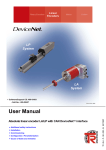
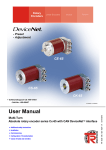
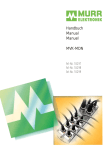

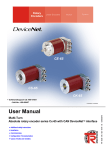
![TestBed User Manual [PDF/1177KB]](http://vs1.manualzilla.com/store/data/005689366_1-da15ee0f5e0f03b5bd1516fa499d012b-150x150.png)
